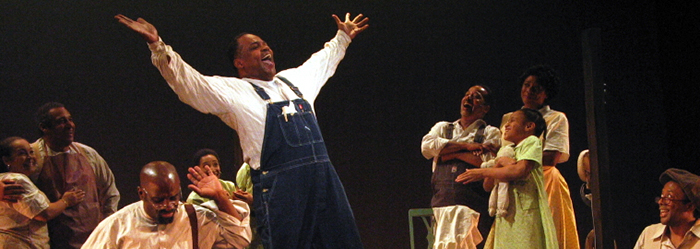
Uncle Jed’s Barbershop is a soul-stirring musical that tells the story of Sarah Jean Carter and her Uncle Jed – the only black barber in 1928 Monroe County, Arkansas – who has a dream of one day opening his own place of business. Flavored by the atmosphere, language, and music of mid-century America, the show is a celebration of hope, love, work, faith, and the power of dreams that never grow old.
Fourteen years in the making, the creation of the musical is a similar celebration. Based upon the award-winning book by Margaree King Mitchell, Uncle Jed’s Barbershop features music and lyrics by David Wohl, book and lyrics by Kenneth Grimes, choreography by Cleo Parker Robinson, musical direction by Michael A. Williams and is directed by Susan Einhorn.
I spoke with David Wohl about the production as he and the crew prepare to launch an extended run at Denver’s Cleo Parker Robinson Dance Theater, beginning September 26.
How did you first get involved with Uncle Jed’s Barbershop?
I discovered the original book (same title) while visiting an exhibit on illustrations from African American children’s books. At the end of the exhibit, there was a room of books from which the illustrations came, and I began to read them. The story and illustrations of Uncle Jed’s Barbershop stirred an emotional response from me, and I immediately perceived the potential for a full length family musical based on the story.
Can you talk about the collaborative process on this project?
Ken, Susan and I began to sketch out the plot of the show, filling out the story, creating new and important characters and situations. Over a number of iterations of the show, things that worked – and which did not work – revealed themselves, and script and songs were modified accordingly. I kept a musical and lyrical journal of ideas, motifs, harmonies, potential dramatic moments, etc., that I could refer to.
How do you describe the show and the music?
This is a show whose family, community, and generational story lines and dynamics tell a powerful and moving universal story for all people of all times. The music is theater music that is both eclectic and “rooted.” Influences include blues, spirituals, romantic music, gospel, Motown, country, and so forth. The main purpose of every musical number is to advance plot and to continually fill out the inner lives of the characters, in a way that lyrics and script (the “book”) can’t do. That is how I approach all the music (and lyrics) that I write.
Can I assume it’s always lyrics first?
Sometimes we start with a lyric, sometimes with a melodic or rhythmic concept. Always, it is with character and situation in mind. As a composer, I often hear a beat and musical pacing prior to writing a lyric, and so I’ll improvise or write some ideas. Other times, I’ll wait for the lyric to make sense, and then marry it to the musical concept later. Usually, the music leads the lyric by a little bit, especially once the general concept and structure of a song feels right.
What about your personal workflow? To you compose at the piano? If so, at what point does Finale enter the equation?
I compose in my head and at the piano. Finale enters the equation once the overall harmonic and melodic structure is established, and I need to get my ideas in written form. The orchestrations follow, naturally, and are continually revised through the rehearsal process.
What is the instrumentation for the show?
Piano/organ, bass, drums, fiddle, guitar/banjo, reed tripler (sax, clarinet, flute), trumpet, trombone. We have 14 actors in this production, and so the vocals are SATB, with moments of 5-6 different parts.
While I understand this is the first fully produced version of the show, I understand it has been a labor of love for some time. Has the music evolved a lot?
Yes! The music has evolved and grown and matured. Songs that always worked have remained. A number of new songs replaced others that were taken out. Lyrics were tweaked, as we understood the characters and the emotional arc of the show better and better. I think I “felt” the singing much better, too, as the years went on, and let go of my “piano” mind a bit. This really allowed the score to soar and fill out more!
Can you describe some of the ways you use Finale to create notation specific to musical theater, or specific to your particular needs?
One doesn’t write a musical; one re-writes a musical. So, you need software that allows you to do that. Certain features in Finale are great for quick changes in sections (meters, tempi, articulations, etc.) And, the syncing of Parts with the score is quite good.
I’d like to thank David for taking time out from his preparations to speak with us, and look forward to seeing the show later this month.
What are you creating with Finale? Let us know by clicking on “comments” below.
The “Uncle Jed’s Barbershop” cast photo, with Ken Prymus in the center, is by Jonathan Slaff